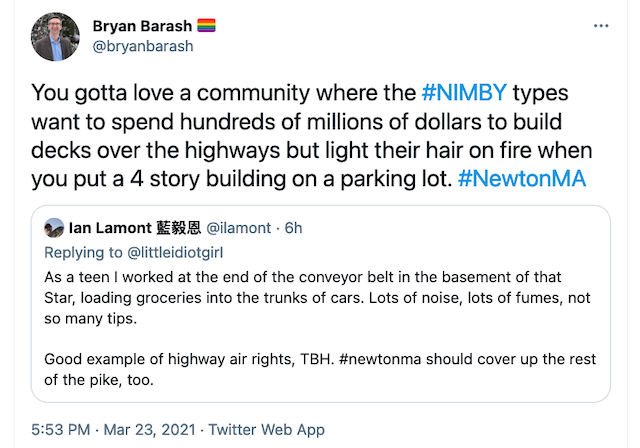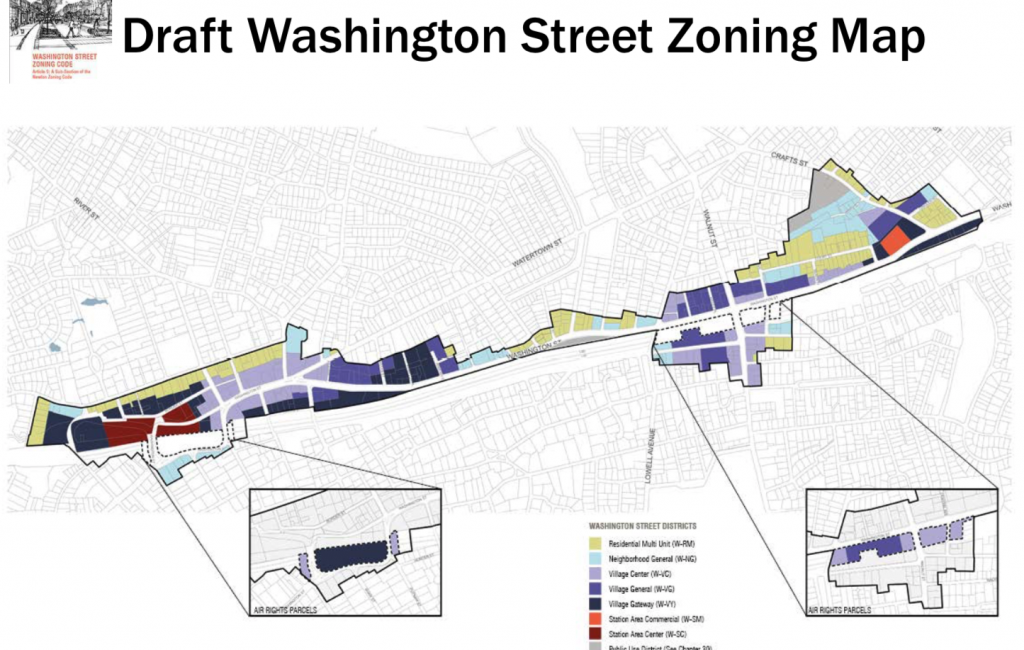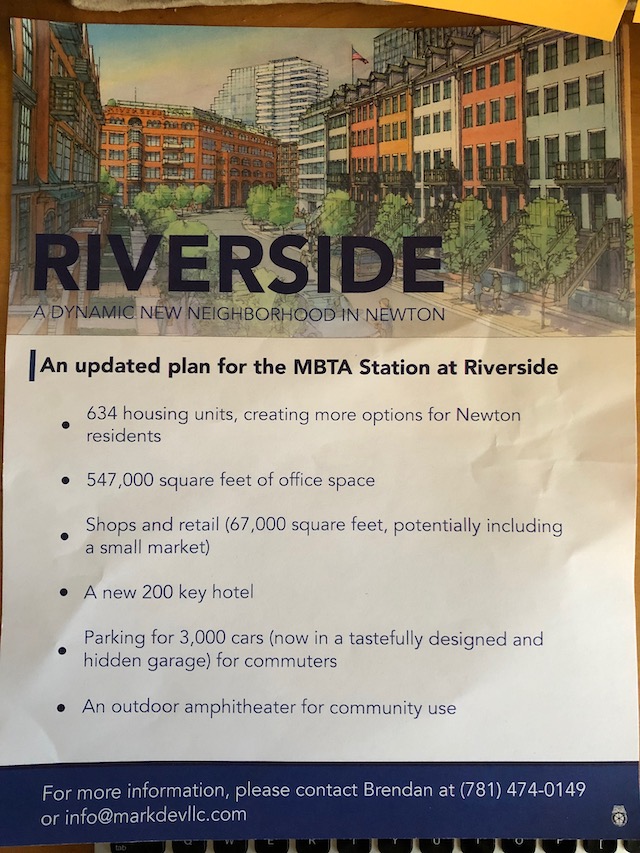The city of Newton is soliciting responses from residents about draft #3 of the Hello Washington Street zoning plan. The area they are talking about stretches from West Newton to Newtonville to the edge of Nonantum. Certainly no one wants to preserve run-down commercial properties, but what the mayor is trying to force on local residents (while trying to portray “Hello Washington Street” as a community-driven plan) is a massive developer giveaway worth hundreds of millions of dollars that burden the city with massive school, traffic, and infrastructure costs for decades to come. City Councilor Emily Norton was absolutely right when she said a few months back that the mayor is “bending over backwards” to accommodate developers.
Personally, I’m extremely skeptical of the way this is being handled (see Riverside and Newton’s draft zoning plans for Washington Street reveal “visioning” for what it really is) but remaining silent is not an option. Here’s the letter I sent to city councilors (residents can email the council at citycouncil@newtonma.gov).
Dear City Councillors,
I am responding to draft #3 of the vision and zoning documents for Washington Street. I have no idea if anyone will read this or any of the other comments I have made, let alone incorporate feedback from residents like me who are greatly alarmed by what’s being proposed. [UPDATE: The council president and several councilors acknowledged receipt] I have seen little change in the core concepts outlined in the successive drafts for Washington Street, despite widespread, vocal opposition from many city residents. Honestly, it seems that the current administration and some councilors would rather take their cues from developers, blogs, and the demands of activists, instead of from the ordinary residents who will be directly and irreversibly affected by this plan. Nevertheless, I want my voice to be heard, even if it is likely to be ignored.
The Zoning Document says:
“There is a strong interest in having varied building heights and cornice lines along Washington Street.”
Judging by the results of the Newtonville Area Council survey and the written comments left in the pop-up community centers when “Hello Washington Street” was launched, the above statement and similar claims made about buildings five or more stories in height are false at least where voters are concerned (from the NAC survey: “There is a strong preference for lower building heights: three or four stories.”). Conclusions in the draft plan that are based on such statements in the zoning document are therefore flawed.
The vision document says:
“Newton needs to create new housing at all levels of affordability in order to protect and promote one of the community’s core values – diversity. The city needs to expand its supply of low-income, middle-income, and even high-income housing choices.”
We have enough high-income housing choices, thanks to the relentless teardown phenomenon and desire of developers to squeeze as much profit as possible at the expense of options for ordinary middle class people, low-income households, seniors, and public workers. The above statement codifies the idea that “luxury”/”market rate” housing *must* be included in planning, which developers will be only too happy to provide en masse – with a mere sliver of options for everyone else. How about inserting language that minimizes or even eliminates the requirement that high-income housing be part of future developments?
The vision document says:
“If Newton is fortunate enough to see congestion because people are coming to shop, dine, work in, and explore the village centers, that is a sign of economic success.”
No resident sitting in a traffic jam on Washington Street in West Newton or Nonantum, let alone Needham Street in Upper Falls, Commonwealth Avenue in Newton Center, Grove Street in Auburndale, or any other thoroughfare, will be thanking city planners for enabling “economic success” at the expense of their time, effort, and other costs associated with driving to work or getting things done.
Many of the comments I have made elsewhere about Washington Street, including letters to the council and using online tools, still stand. Below, I am including my comment from March 10, 2019, which I submitted online but never got any response to and may not have been registered.
Sincerely,
Ian Lamont
My March 10 comment:
I appreciate the work that the planning dept has put into this plan, and the opportunity to redo some of the dilapidated sections of Washington Street. However, I and many other residents of Newton strongly object to the new “Village Gateway” (W-VY), “Station Area Central” (W-SC), and “Station Area Commercial” (W-SM) zoning designations. I have to ask how this was slipped into the plan considering the widespread public opposition to giant buildings expressed in surveys and the city’s own feedback-gathering process in the past year.
According to the draft, the maximum height *by right* for all of these zones will be 5 stories. If developers successfully apply for special permits at any of those sites (a requirement to maximize the value of their investments) they will be able to place gigantic buildings between 6 and 10 stories tall throughout West Newton. Village Gateway also appears in Newtonville to the edge of the Lake.
I’m sure developers and the tax office loves this prospect, but it’s not what residents asked for according to the Newtonville Area Council survey in October and the comments left in the pop-up community centers.
I participated in the early “Hello Washington Street” visioning process. The following comments were left by citizens on one of the “pop-up” centers in West Newton to collect feedback about Washington Street. Here’s what residents wrote when presented with a poster of large buildings:
“Too tall”
“Too big”
“Bad shadows”
“Big buildings ugly”
“Too urban”
“Air rights over pike”
“This doesn’t look like a suburb. Where are the trees?”
“No trees. Towers destroy neighborhood feel”
“Too tall. Too many people for the space. Too many cars. Overshadows existing homes. Overcrowding of the school system.”
“Seniors have few school age children and many no longer drive.”
“This is bogus. So unappealing I;m sure it’s only offered to make the other scenarios look better by comparison. West Newton resident.”
“No. This is not Boston. We do not have to agree to make Korff rich.”
“Never. We don’t wan’t Manhattan. “
“Have you been to Manhattan?”
“I love Manhattan and Tokyo.”
“No high rises in Newton!”
“Be careful. You will drive away all of the [] who make Newton a magnet.”
“No one who wants to make Newton a magnet can afford to live here now.”
“Underground parking is good. But these cars will still be driving around the city.”
“Way too tall. Big shadows on small houses.”
“Large number of affordable units”
“Build this over the pike”
“What about the existing residents who cannot unfortunately [] this monstrosity”
“Boston? MGH?”
In summary, almost NO ONE who lives in the city asked for developers to be granted 5 stories by right, or 10 stories by special permit. Even 4 stories is a stretch, considering the major impact on traffic, schools, and other infrastructure.





